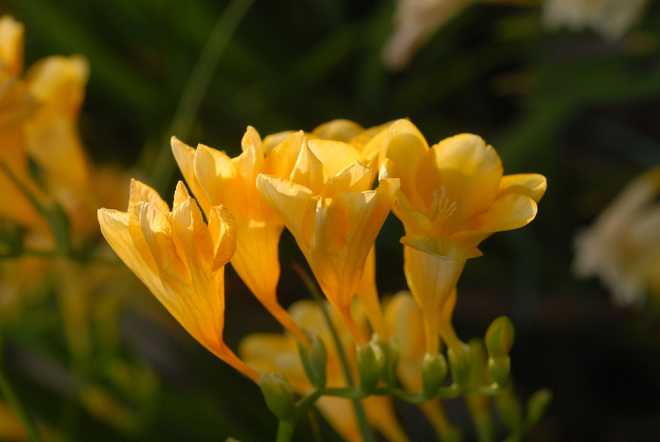
Amarjeet Singh Baath
Freesia is a half hardy from gladiolus family and is a lesser known flowering beauty that has not caught the fancy of many garden enthusiasts, especially in North India. Despite its exotic looks, alluring fragrance, trumpet shaped upward pointing flowers on leafless stems with a range of colours, its presence is limited only to flower shows. Those looking to add fresh appeal to their collection of flowering plants should check out this exotic-looking plant.
Pot mixture
Take equal parts of garden soil and well-rotten farm yard manure and mix them thoroughly so that no clumps remain, add a ‘neem’ cakes and bone meal to it.
When to plant
Freesia corms are planted in mid-October. Even the small corms also produce flowers which may not be of desirable quality. The fully developed corms bloom early followed by new small corms. Flowers appear within 10-12 weeks and remain in bloom for two to three weeks depending upon the weather condition and care.
Post planting care
It is very easy to grow Freesia in this sub tropical region. All it requires is sunlight, moist well-drained soil, weeding, hoeing and regular fortnightly feeding. Periodically keep on rotating pots at regular intervals for balanced sunlight.
Once the flowering is over and bloom has died, it’s the time when Freesia is entering the inactive phase of its life cycle. Let the pot remain in sunlight for 2-3 months to store energy for next season bloom. Keep on maintaining the plant with normal routine garden operations like fertilisation, watering and hoeing etc. Wait till the green leaves turn yellow. It’s then time to prune the plant, remove dried and dead leaves. Move the plant in to a cool dry place to allow it to enter dormancy. Reduce water to just keep the soil lightly moist as good as dry.
If the plants are a few years old, consider them for multiplication. Take out the entire plant from the pot and gently separate all the corms and remove the soil and place them on a newspaper. Separate the old parent corm from the new young corms for further propagation. Withdraw the corms and air dry and wrap them in a news paper and store them in cool dark place.
Diseases
If the storage conditions are not proper, pupa formation occurs on the corm and effect the plant health. During rainy season be careful about fungal infection and treat with ‘Bavistin’.
Where to plant
Freesia looks magnificent when grown in groups of single colour or in colour harmony rather than in lines. A mass feeling is desirable when grown in flower bed and compactness in pots. Choose a sunny location when planting in a flower bed and if potted keep it on a south-facing window or wall side direction where it gets maximum sunlight for a long duration. Also ensure that the flower bed location in not a low patch in the garden which accumulates water as the plant flourishes only on well-drained soil. Water logging causes rotting of corms.
How to plant
The preferred size of pots is 10” to 12”. Plug the drain hole with a cork and settle the prepared pot mixture in layers and fill the pot up to one inch below the pot rim. Take out ball of soil to the size of the corm and place the corm with growing point upwards. Insert the corms five cm under the soil at 5-8 cm apart. Fill the sides of the corm and fill the pot with the prepared mixture and irrigated it immediately. Thereafter keep the pot wet do not over water.



























